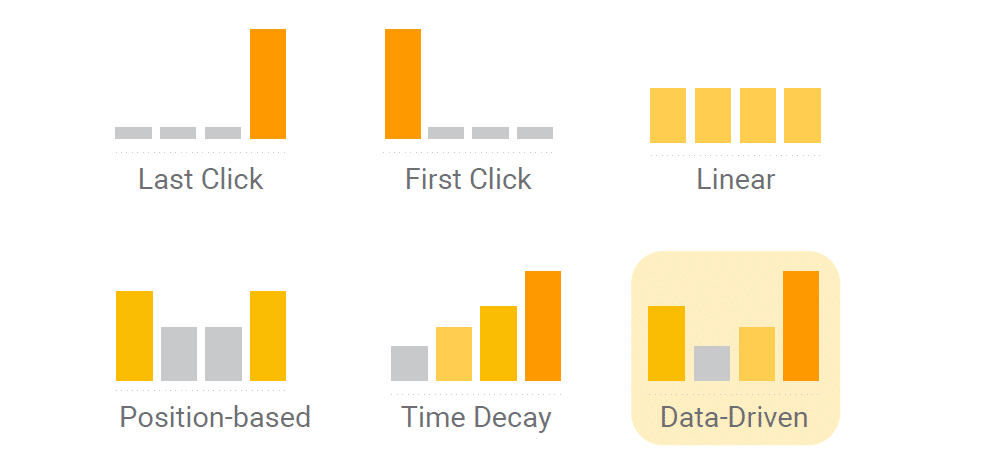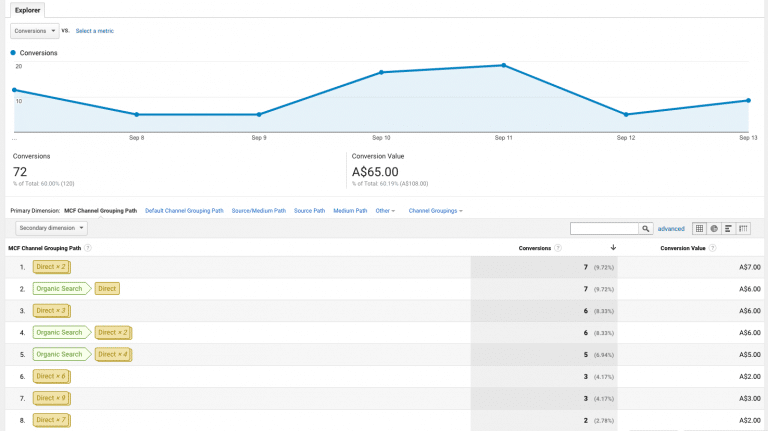
Deciding where, when and how much to spend on a marketing channel such as Google Ads or Facebook marketing can be complicated and difficult without understanding the conversion path your customers take. On the way to a conversion — whether a purchase, a download or contact — a customer often searches for a variety of keywords and interacts with a variety of ads.
By using an attribution model in Google Analytics, you get an overview of the conversion path, giving you a better understanding of the role of each ad and keyword in the conversion path and how it performs. This enables you to optimise the conversion path to enhance the conversion rate, maximise marketing spend and enhance the effectiveness of your marketing campaign.
Attribution modelling is incredibly insightful and helps you to understand buyer behaviour, such as:
- Why people buy from you
- What happens before they buy
- What influenced their buying decision (or decision to complete another goal)
Additionally, it helps you find opportunities to influence customers earlier in the conversion path and optimise your bids, improving your conversion rate and maximising your marketing spend.
Attribution modelling can be leveraged to identify the most effective marketing channels to allocate budget to. This is a better way of evaluating individual ad performance and the overall performance of the campaign than only considering the number of completed conversions.
By measuring the financial effectiveness of individual communication channels and their impact on business goals, you gain powerful insights into which sources help you achieve your goals, enabling you to allocate your marketing budget accordingly.
This doesn’t mean allocating all your budget to the highest performing ads, but rather allocating the right amount of budget to each ad in the conversion path based on the importance of the role it plays in getting customers to convert.
When you understand the paths users take to complete a goal, you can improve marketing performance by influencing customers at the right touchpoints in the conversion path, reducing wasting spend through better budget allocation and, ultimately, increase marketing profitability.
Selecting the right attribution model for the way people search for your products and services is important, as using the wrong model risks wasting budget and missing out on opportunities to optimise ads and influence customers at the right touch points in the conversion path. Only when you have a solid understanding of the different attribution models should you switch from Last Click, the default model in AdWords, to another attribution model.
Originally the local pack appeared down below the organic listings and showed 7 businesses:
Google Analytics Attribution Models
Attribution modelling can measure many metrics — conversions, sales, revenue, impressions, click through rates and more — and there are seven attribution models in Google Analytics you can leverage to gain powerful insights into your marketing spend. The attribution models are:
- Last Non-Direct Click
- Last Interaction
- First Interaction
- Last Google Ads Click
- Linear
- Time Decay
- Position Based
The default model for conversions in Google Analytics is Last Non-Direct Click. As this model attributes 100% of conversion value to the last channel the customer clicked through before converting, you may find it advantageous to choose a model that better suits the way people search for your products and services. There are advantages to using this model, for example, using it as a benchmark for result comparisons with other models and filtering out direct traffic to identify the last marketing activity in the conversion path.
As it attributes 100% of conversion value to the most recent ad clicked before converting, the Last Google Ads Click model is most commonly used to identify the Google Ads ads which deliver the most conversions.
The Last Interaction model attributes 100% of conversion value to the last channel in the conversion path and is particularly useful for transactional businesses with sales cycles that don’t involve a consideration phase as in a traditional sales funnel. If the purpose of your ads and campaigns is to attract customers at the moment of purchase, this model is ideal.The opposite of the Last Interaction model, the First Interaction model attributes 100% of conversion value to the first channel interacted with in the conversion path. This is the model to use when ads or campaigns are intended to create initial awareness around a product or brand.
The ideal model for campaigns intended to maintain contact and awareness with customers throughout the entire sales cycle, the Linear model attributes credit equally across all channels interacted with on the way to conversion. This means that every touchpoint in the conversion path is given equal credit.
The Time Decay model is ideal for sales cycles with a short consideration phase, for example, a one or two-day promotional campaign. Based on the concept of exponential decay, it most heavily attributes credit to the touchpoints nearest to the conversion. This means that the last touchpoint receives more credit than the first touchpoint. As it has a default half-life of 7 days, a touchpoint on the day of the conversion receives twice as much credit as a touchpoint 7 days prior to the conversion and 4 times the credit as a touchpoint 14 days prior. And so on.
The Position Based model enables you to create a hybrid model of the Last Interaction and First Interaction models. A common method is to assign 40% to the first and last touchpoints and divide the other 20% across the remaining touch points. While advantageous in many scenarios, the downside is that it assumes the first and last touch points are equally important.
To view your campaign’s top conversion paths, go to GA > Conversions > Multi-Channel Funnels > Top Conversion Paths.

To compare the results from different attribution models, go to GA > Conversions > Attribution > Model Comparison Tool.

Here you can compare results from up to three attribution models side-by-side which is helpful when determining which attribution model best reflects your marketing goals and business model.